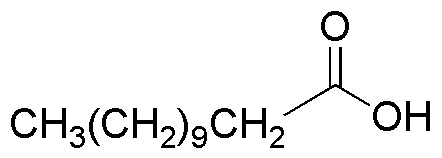Lauric acid is widely utilized in research focused on:
- Cosmetics and Personal Care Products: This fatty acid is a key ingredient in many skin care formulations due to its moisturizing properties. It helps to improve skin hydration and can enhance the texture of creams and lotions.
- Food Industry: Lauric acid is found in coconut oil and palm kernel oil, making it valuable in food production. It is used as a flavoring agent and preservative, providing a natural alternative to synthetic additives.
- Pharmaceuticals: In the pharmaceutical sector, it serves as an excipient in drug formulations. Its ability to enhance the solubility of certain medications can improve their bioavailability.
- Surfactants and Detergents: Lauric acid is a vital component in the production of surfactants, which are used in cleaning products. Its effectiveness in breaking down oils and fats makes it ideal for household and industrial cleaners.
- Biodegradable Plastics: The compound is being explored for use in the development of biodegradable plastics. Its natural origin and biodegradability make it an eco-friendly alternative to conventional plastic materials.
General Information
Properties
Safety and Regulations
Applications
Lauric acid is widely utilized in research focused on:
- Cosmetics and Personal Care Products: This fatty acid is a key ingredient in many skin care formulations due to its moisturizing properties. It helps to improve skin hydration and can enhance the texture of creams and lotions.
- Food Industry: Lauric acid is found in coconut oil and palm kernel oil, making it valuable in food production. It is used as a flavoring agent and preservative, providing a natural alternative to synthetic additives.
- Pharmaceuticals: In the pharmaceutical sector, it serves as an excipient in drug formulations. Its ability to enhance the solubility of certain medications can improve their bioavailability.
- Surfactants and Detergents: Lauric acid is a vital component in the production of surfactants, which are used in cleaning products. Its effectiveness in breaking down oils and fats makes it ideal for household and industrial cleaners.
- Biodegradable Plastics: The compound is being explored for use in the development of biodegradable plastics. Its natural origin and biodegradability make it an eco-friendly alternative to conventional plastic materials.
Documents
Safety Data Sheets (SDS)
The SDS provides comprehensive safety information on handling, storage, and disposal of the product.
Product Specification (PS)
The PS provides a comprehensive breakdown of the product’s properties, including chemical composition, physical state, purity, and storage requirements. It also details acceptable quality ranges and the product's intended applications.
Certificates of Analysis (COA)
Search for Certificates of Analysis (COA) by entering the products Lot Number. Lot and Batch Numbers can be found on a product’s label following the words ‘Lot’ or ‘Batch’.
*Catalog Number
*Lot Number
Certificates Of Origin (COO)
This COO confirms the country where the product was manufactured, and also details the materials and components used in it and whether it is derived from natural, synthetic, or other specific sources. This certificate may be required for customs, trade, and regulatory compliance.
*Catalog Number
*Lot Number
Safety Data Sheets (SDS)
The SDS provides comprehensive safety information on handling, storage, and disposal of the product.
DownloadProduct Specification (PS)
The PS provides a comprehensive breakdown of the product’s properties, including chemical composition, physical state, purity, and storage requirements. It also details acceptable quality ranges and the product's intended applications.
DownloadCertificates of Analysis (COA)
Search for Certificates of Analysis (COA) by entering the products Lot Number. Lot and Batch Numbers can be found on a product’s label following the words ‘Lot’ or ‘Batch’.
*Catalog Number
*Lot Number
Certificates Of Origin (COO)
This COO confirms the country where the product was manufactured, and also details the materials and components used in it and whether it is derived from natural, synthetic, or other specific sources. This certificate may be required for customs, trade, and regulatory compliance.

